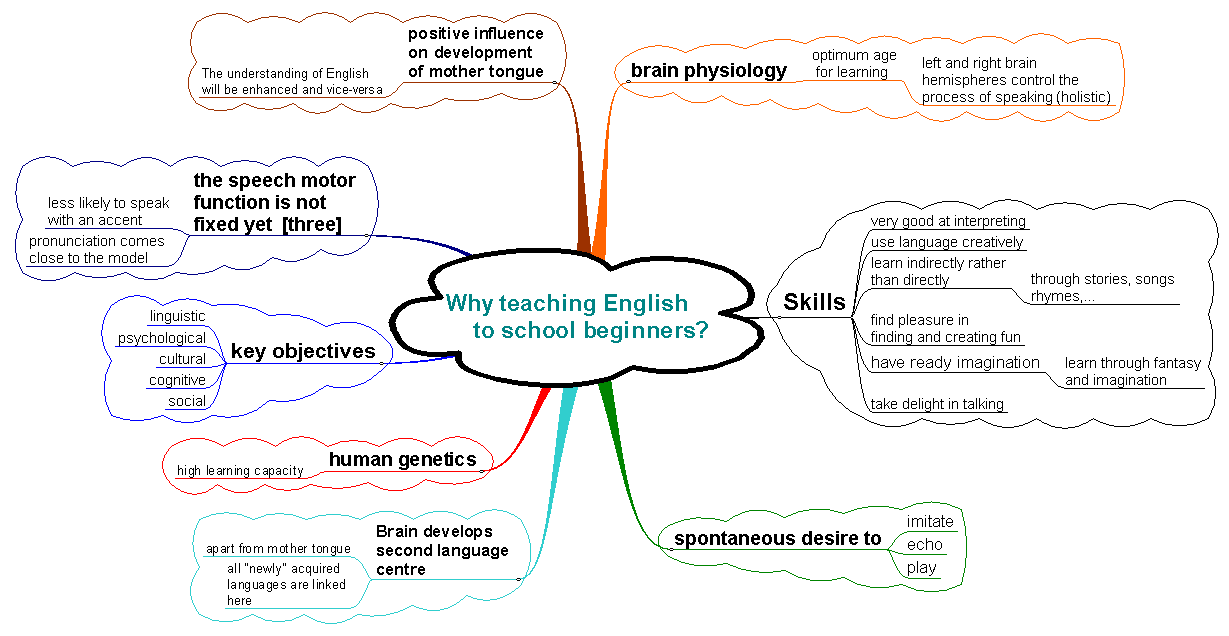
Did you know that…
Some words of common sense from Susan Halliwell (1992:3) on working with Young Learners:
Young children do not come to the language classroom empty-handed. They bring with them an already well-established set of instincts, skills and characteristics which will help them to learn another language. We need to identify those and make the most of them.
· For example, children:
are already very good at interpreting meaning without necessarily understanding the individual words;
· already have great skill in using limited language creatively;
· frequently learn indirectly rather than directly;
· take great pleasure in finding and creating fun in which they do;
· have a ready imagination;
· above all take great delight in talking!
The decision to introduce foreign language learning into primary schools is, according to its supporters, one that has identifiable advantages.
Brewster, Ellis & Girard (1992) make the following points:
Advantage can be taken of certain aptitudes children have in order to start teaching a foreign language at primary school..
· Early learning of a non mother-tongue language must be integrated into other teaching in the primary school.
· Whatever else may be achieved, the main concern is to prepare the ground so that the most can be made of the teaching which will be received in secondary school. (1992:19)
Are there any other key objectives for teaching a foreign language to young learners apart from the age factor?
Later on, the same writers (1992:24) summarise the key objectives of early foreign language learning as: linguistic, psychological and cultural.
But there are other advantages, too: cognitive and social. Research carried out in India by Mohanti (1994) and reviewed by Tove Skutnabb-Kangas very positively in TESOL Quarterly (1998) has shown that bilingualism
from an early age promotes cognitive development and
has wide-ranging social advantages.
So here already we have five broad reasons other than the age factor to justify early second language learning.
Brumfit (1991a:vi-vii) outlines some of these reasons in more detail, but goes on to point out that there isn't much 'theoretical agreement over exactly what the advantages are'
The European Commission claims another advantage:
The earlier children begin learning foreign languages, the better their progress tends to be. The chances of creating a Europe of multilingual
citizens will be greatly improved if citizens have access to language learning at primary school or before.
There are mountains of evidence from recent research into the workings of the child’s brain that early foreign language
learning, if done properly, can contribute significantly to the cognitive development of the child. These findings come on top of observations of how young children are especially well able to learn a foreign language. As Susan Halliwell has pointed out, they bring along a whole
set of specific aptitudes or skills.
THE ABILITY TO GRASP MEANING.
Before toddlers know the exact meaning of individual words, they are able to understand
the sense of complete utterances. Intonation, mime, gesture, and the context between what was said and the environment of an
utterance help them to decode what they have heard.
THE ABILITY TO MANAGE WITH LIMITED LINGUISTIC MEANS.
Children frequently “play” with language and try to increase their language abilities, which are often quite limited, by
transferring what they have learnt into other contexts and by making up new words or expressions. Frequently, for example, words in the mother tongue are pronounced in “English” when a child can’t think of the word in the target language. For the teacher, all these
phenomena are evidence of the children’s learning process.
THE ABILITY TO LEARN INDIRECTLY.
Very young learners do not learn vocabulary, structures or phrases as separate entities. They are intrigued by stories and try
to understand them. They like the sounds of the new words that the teacher introduces and enjoy repeating them. They have fun with songs and chants and move enthusiastically when they sing along. They want to find the answers in a guessing game and eagerly use the structure that
the teacher has introduced. They act out scenes from a sketch in class, and when they do, they imitate the voices of the animals or other characters they are playing so well that their pronunciation comes very close to the models that they had previously heard on the video. In
all these cases, and in many others, children are unconsciously learning very important linguistic skills. Here, language is not an end in itself, but a natural means of reaching a communicative goal.
THE ABILITY TO LEARN THROUGH FANTASY AND IMAGINATION.
Children know a glove puppet is not alive. And yet, when the teacher uses such a puppet to communicate with the children, the
line between make-believe and reality is blurred. Play becomes reality, and in such play situations children make the foreign language their own.